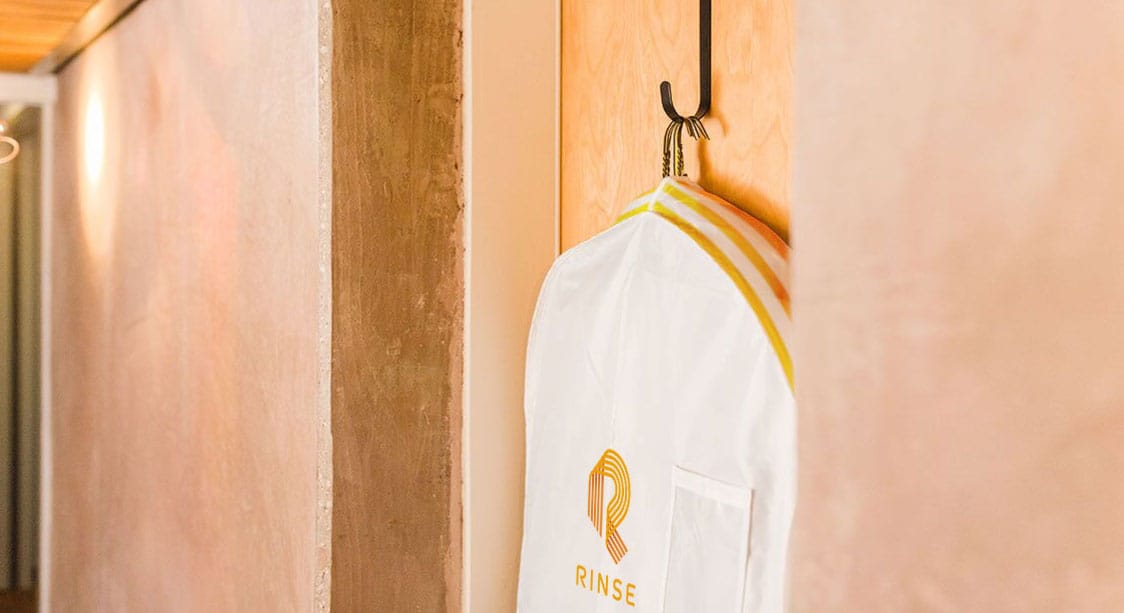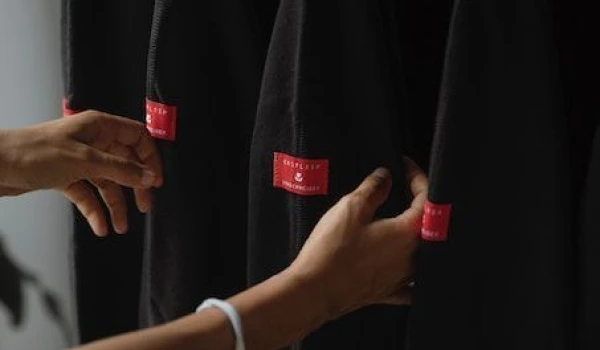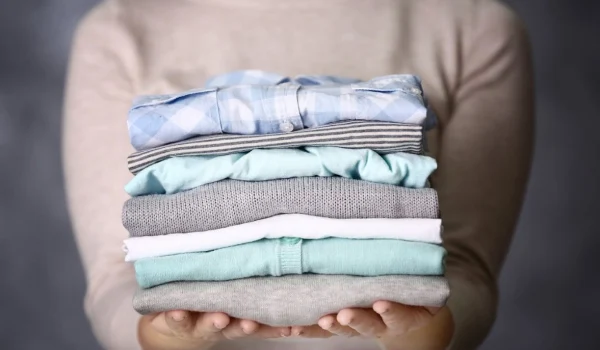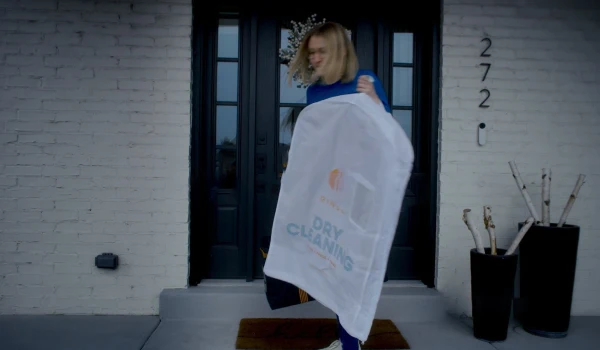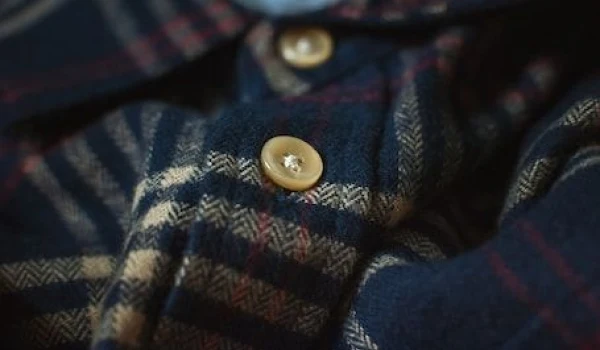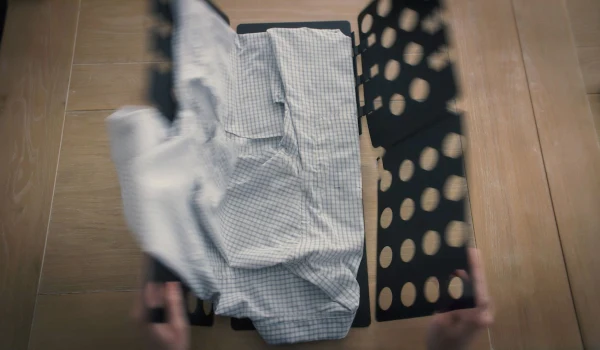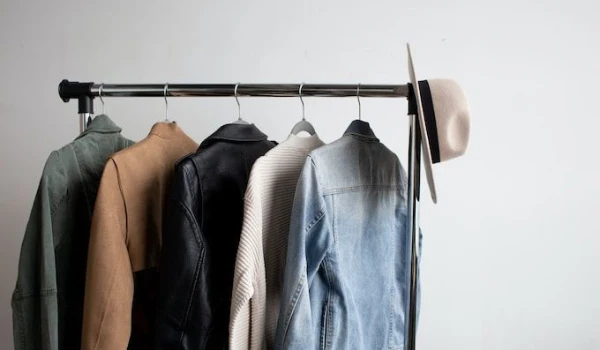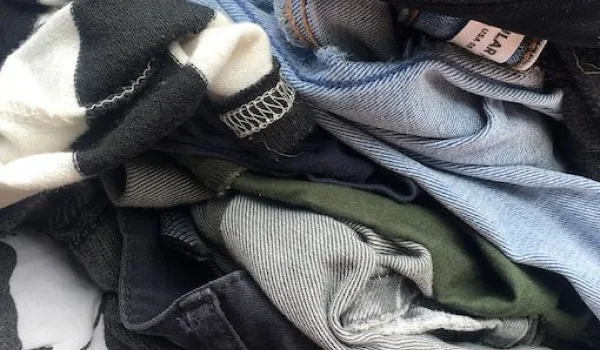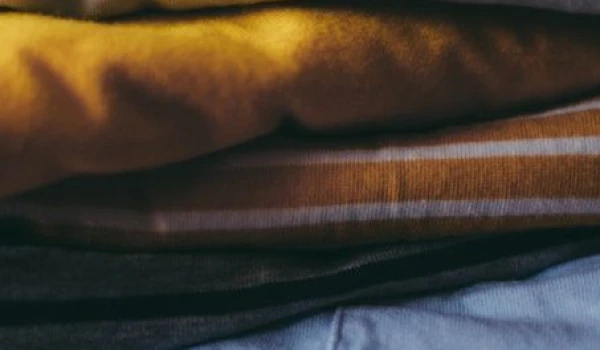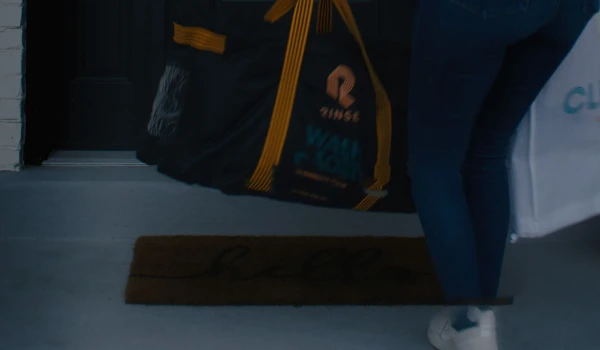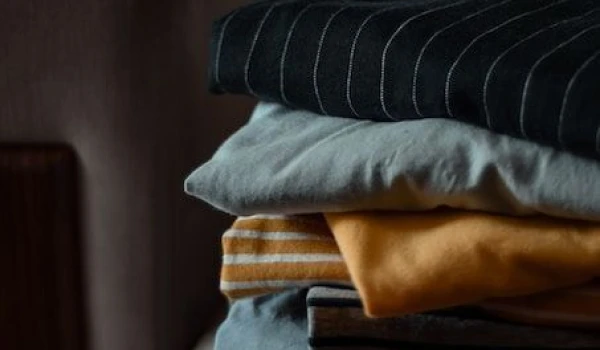Care
Clothing care tips to make your wardrobe last
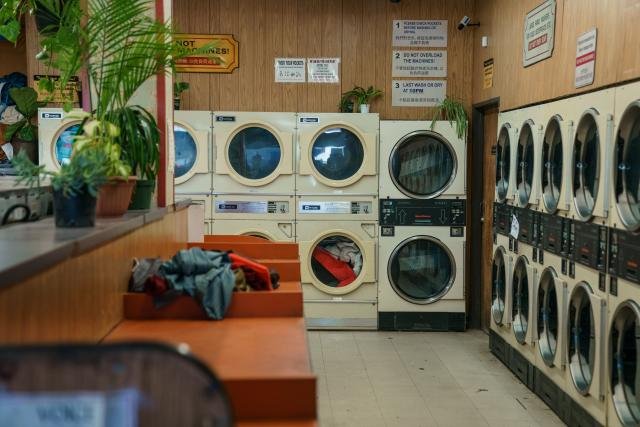
The Rinse Team was rooting for Everything Everywhere All at Once) at the 95th Academy Awards last week for a few reasons. For one, it’s a great movie. Exploring themes of generational trauma and the multiverse, it deserved all 7 of the Oscars it won. Second of all, the critical acclaim of the film is a major win for Asian American representation in Hollywood. And, of course, we loved the laundromat scenes. The real-life laundromat in LA, where several key scenes were filmed, has been flooded with tourists since the movie's release. Finally, people are appreciating the art of laundry!
We’re not in the business of movie reviews, though. We’re in the business of clothing care. At the end of the day we are #LaundryNerds and can’t help but dream about how we would clean the cast’s fabulous outfits worn on the Oscars Academy Awards red carpet. So we asked our co-founder, COO, and in-house clothing care expert, James Joun, how he would go about caring for some of these garments.
 Michelle Yeoh Wins Best Actress
Michelle Yeoh Wins Best Actress
Michelle Yeoh, who won the Oscar for best actress in a leading role, wore a stunning white Dior ballgown with a mesh bodice and angelic layers of feather fringe. Exposed feathers are an extremely delicate (and expensive) material, which makes them a rare item to clean. This dress makes our hearts flutter, and takes the question ‘how to wash white clothes’ to the next level.
Since our COO and Co-founder, James Joun, grew up helping around his parents’ dry cleaners, we asked him to share his clothing care expertise on how to clean this gorgeous gown with special attention for its delicate feather skirt.
“We’d start by gently hand washing only the feathers that appear dirty,” says James. “There isn’t a standard method for attaching feathers, so you’ll want to do everything you can to avoid damaging the glue or clasps that hold the feathers to the garment. We would delicately swish the feathers through a solution of warm water and mild detergent, never scrubbing, so we don’t risk having the feathers clump or lose their shape.”
As experienced dry cleaners, looking at the length of her dress we also know that the underside of her train would likely have marks from her high heels (especially after all the much-deserved celebrations) that we’d want to remove before returning this glamorous garment to Michelle.
 Ke Huy Wuan Wins Best Supporting Actor
Ke Huy Wuan Wins Best Supporting Actor
Ke Huy Quan, who took home the Oscar for best supporting actor, donned a timeless black tuxedo on the Academy Awards red carpet. His classic black single-breasted tux is by Armani and he accessorized with an Art Nouveau flower brooch. Ke Huy told a reporter it was the most beautiful tux he’d ever worn and we’d have to agree.
Luckily we have a lot of suit dry cleaning experience at Rinse. First step, we’d make sure Ke Huy remembered to remove those stunning brooches. Then we’d get down to business with our green dry cleaning methods. Want some tips on how to properly care for your suit? Read our guide to caring for suits here.
 Jamie Lee Curtis Wins Best Supporting Actress
Jamie Lee Curtis Wins Best Supporting Actress
Jamie Lee Curtis accepted her Oscar for best actress in a supporting role wearing a crystal-encrusted gown from Dolce & Gabbana. According to James, ”Ornamentations, such as sequins and beads, are notoriously difficult to protect and can be easily damaged by the heat of the cleaning and drying process. Heat can melt either the ornamentation itself, or, if the ornamentation is affixed to the garment using glue, it can melt the glue. To optimize for safety, my strong recommendation would be to hand-wash the garment in lukewarm water and hang to dry.”
Once the dress had air dried, we would check it one more time to make sure it’s impeccable and before delivering it back to Jamie for the next time she needs to sparkle on the Oscars Academy Awards red carpet.
 Everything Everywhere All At Once wins Best Picture at the 95th Academy Awards
Everything Everywhere All At Once wins Best Picture at the 95th Academy Awards
Did you know co-director Daniel Scheinert thrifted his Academy Awards suit? We 100% support it. Whoever owned that suit before him definitely knew the importance of dry cleaning! Thanks for indulging us #LaundryNerds as we mused about how we’d clean these iconic looks. Until next awards season!

Learn more about the entire lifecycle of clothes!

Often our favorite garments are those with good stories. Maybe that special piece of clothing was a gift or worn at a memorable event. But have you ever considered the story of the garment before it became yours?
The life of a garment is not a boring life, that’s for sure. From fiber to textile production, design, and fabrication, to transport and retail sales, every article of clothing is the culmination of lots of effort and imagination.
Historically, people held onto garments for a long time, but with cheap clothing now abundantly available, many societies throughout the world think of clothing as disposable. The staggering volume of new garments manufactured each year have made this paradigm shift possible.
Clothing Production
150 billion garments per year are produced in the global fashion industry, which means about 20 items per person.
Cotton is the most commonly used raw material for fabric in the world, with 60% of women’s garments and 75% of men’s garments containing some cotton. Once the cotton fiber is harvested, it’s spun into a fabric which can be easily cut to specific design requirements.
The fabric is sold to clothing manufacturers, who manage the actual production and fabrication of the garments. Once production is complete, garments are shipped to a distribution center, where they are stored until needed at retail locations.
The Typical Lifecycle of a Garment
After the garment is sold, it may be used once, dozens of times, or never at all, before it ends up being thrown away, repurposed, or recycled.
So how many times are garments generally worn? Although there is little data currently available, a detailed survey of almost 2,000 women found that the majority of fashion purchases see the outside of the wardrobe just seven times.
As a result, Americans sent 14 million tons of clothing to landfills in 2018, all while continuing to purchase new garments at a frenzied pace. To put this in more relatable terms, the average American now generates 82 pounds of waste just from clothes they throw away every year!
Adding to the concern, more than 60 percent of fabric fibers are now oil-based synthetics, meaning if and when our clothing ends up in a landfill, they don’t decay.


Despite these large numbers, a problem at such a massive scale does in fact start with actions at the micro level. How many times you wear your garments, and how you dispose of them once it’s time to let them go, both define the life of your garment.
According to the Council for Textile Recycling, nearly one-half of used clothing is given away for donations by the general public. Simply donating your used clothing instead of throwing it away makes a significant impact on the life of your garment, and there are incredibly convenient ways to make it happen.
With Rinse, clothing donations pickup is always free during any one of your scheduled pickups, and it is a great way to extend the life of your garments by giving someone else the opportunity to enjoy them. Another way to counteract the problem of excessive clothing waste is to increase the number of times you wear your garments. A good rule of thumb is to aim for at least 30 uses.
To get to 30 uses, it’s important to ensure the proper care and cleaning of your clothes. When washing clothes, use cold water, as it’s not only helpful in preventing color bleeding and fading but helps to preserve the strength and integrity of the fibers.
Additionally, you can switch from high or medium heat to low heat in the dryer, which also helps to increase the longevity of your garments and reduces the risk of shrinkage and malformation of clothes over multiple cleanings. Or working with Rinse or your local cleaner can help!
So next time you slip into your favorite garment, take a moment to consider not only where it came from, but also where it’s going. And when you choose to extend the life of your garments, you’re making a choice that benefits more than just your wardrobe.

1. Wash between wears
2. Pretreat your stains
We recommend treating any stains before washing. Our favorite is OxiClean™ Versatile Stain Remover because when its oxygen-based formula is activated by water, it lifts and removes stains from fabrics of all colors.
3. Separate by color
White clothes and linens should always get their own wash cycle to prevent dyes from bleeding onto your whites and making them dingy.
4. Choose a whiter, brighter clean
At Rinse, we use OxiClean™ Liquid Detergent to bring back your bright whites and revive colors. This detergent is tough on stains but gentle on your clothes so they last for years to come.
5. Give your clothes room to move
It’s tempting to fill your washer to the brim but your clothes need room for your machine to work it’s magic. Detergent and water need to be able to circulate through your clothes to break soils down and wash them away.
6. Always follow your garment’s care label
The label will indicate the ideal water temperature needed for best results. If you’re ever stumped, see our easy guide here.
We’re always happy to share tricks of the trade to clean your clothes and help them last, but if you have things you’d rather do with your time than laundry, remember, we’re always here to care for your clothes!

Discover the best practices to follow when ironing at home.
Introduction
Ironing may seem like a tedious chore but it’s important to remember to iron your clothes to maintain them. Not to mention, you don’t want to be well-dressed and feeling confident only to have your outfit stand out (in the wrong way) for wrinkles that could have been avoided if you knew how to properly iron your clothes.
Read our tips and tricks below and learn how to correctly iron your clothes in no time!
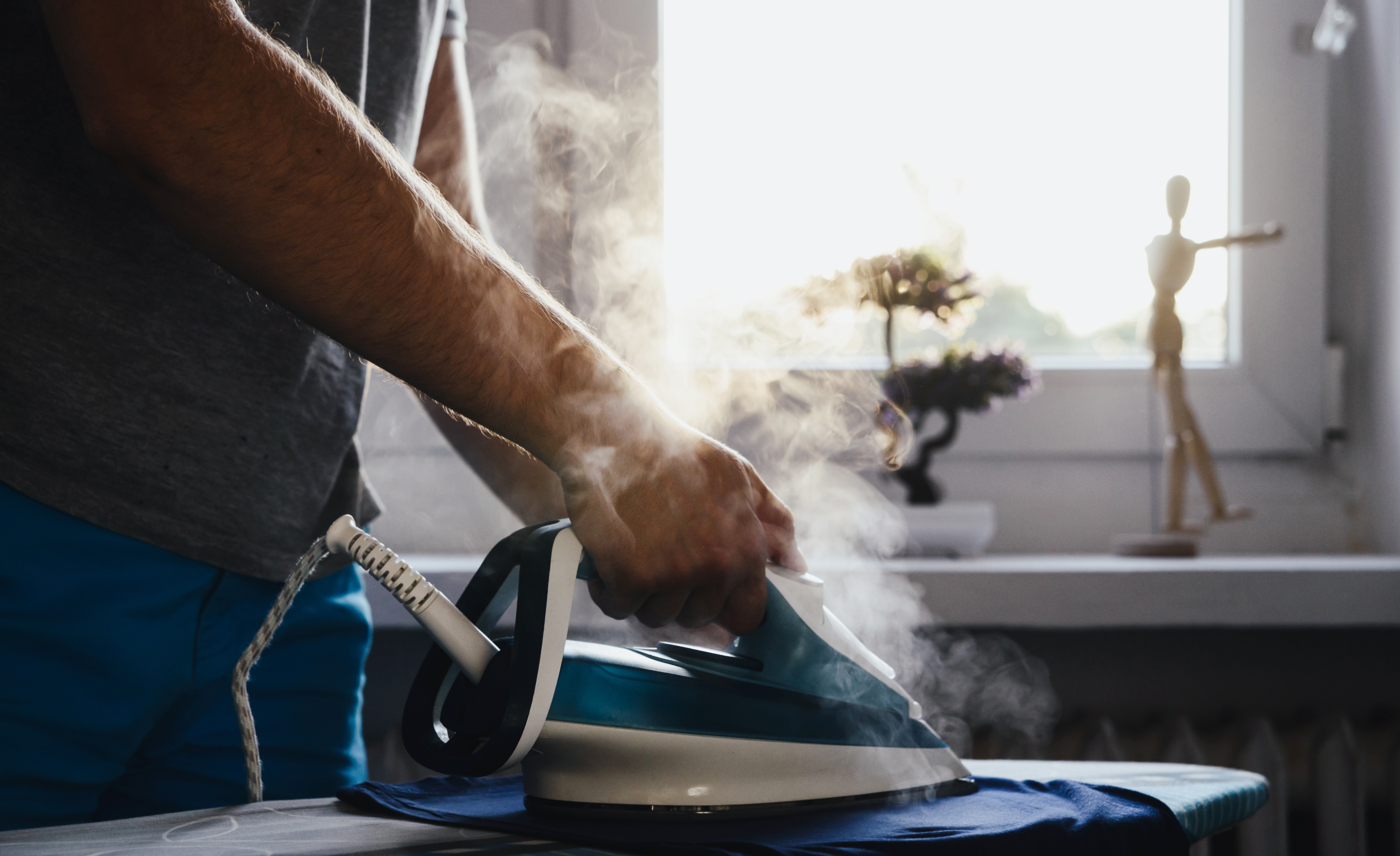
How to Iron Clothing
Let's begin by looking into how to iron the most common pieces you'll find yourself with. Note that you will require the following items:
- Iron (filled with water)
- Ironing board
- Spray bottle
Shirts
-
Take your shirt and place it flat on an ironing board, without stretching the fabric.
-
Start at the cuff of the shirt and press the iron up towards the shoulder. It is okay if the sleeves start to dangle off the board as you iron the center of the shirt. Use the tip of the iron to get around buttons.
-
Keep rotating the shirt as you go from the center to the back, always ironing side to side.
-
Don't forget the collar, ironing it up and down.
-
If you cannot remove wrinkles or there is a specific one resisting, see if your iron has a steam function that you can use to loosen the fabric. Press with the iron afterward.
Pants
-
Place your pants on the ironing board and press the iron back to front and bottom to top, starting at the ankle.
-
Start with one leg and then the other, using a circular or wiggling motion.
-
Fold down any creases your pants may have and iron on top.
Dresses
-
Check to make sure all pieces of your dress can be ironed (e.g. remove any belts or materials that would melt with an iron).
-
Start with the collar and use a side-to-side technique to remove wrinkles.
-
Next, iron loose flaps on the reverse edge before moving onto shoulders and sleeves.
-
Lastly, tackle any wrinkles on the body of the dress, starting at the top and working your way down.

Best Iron Temperature Settings for Each Fabric
While we now know how to iron, the next question becomes what is the ideal temperature to use. The answer is that it depends on the fabric.
While you should always consult the care label of your garment to confirm, below we discuss the most common fabrics and their recommended ironing temperature.
Low Temperature
-
Silk: This fabric is called delicate for a reason! Turn the silk garment inside out and use the lowest possible heat setting on your iron. If available, it is better to steam the piece (either with a steam iron / steamer) than to iron silk. If you are ironing it, do not hold the iron for too long in one place to avoid burning the silk.
-
Acetate: Another delicate fabric that should be ironed inside out and on the lowest heat setting.
-
Polyester: This fabric can sometimes handle medium temperatures, but we recommend playing it safe and using a lower one.
-
Lace: This is a delicate one too – treat it the same way you would approach a silk garment.
-
Rayon: A delicate material that should be ironed like a silk piece.
Medium Temperature
- Wool: Never iron wool directly – use a damp cloth over the fabric and iron on top, making sure you do not press too hard.
High Temperature
-
Linen: It is recommended to iron a linen garment while it is still damp, using a high temperature.
-
Cotton: This fabric is tough to iron and is known for wrinkles that are hard to remove. As such, it is recommended to dampen your cotton dress shirt or garment by lightly spraying water on wrinkles. It is okay to press hard with the iron with cotton.

The Benefits of Ironing Your Clothes
The top reason to iron your clothes, shirts, in particular, is to limit the number of visible wrinkles. It’s definitely embarrassing to be walking around in public with wrinkles on your clothes. And you'll never get a second chance at a first impression so it’s a good idea to make sure you’re not looking too sloppy as you never know who you’ll meet or run into.
Additionally, ironing can help you preserve your clothes. The steam from an iron manipulates the fabric of your clothes so that they soften and return to their original state, thus, extending the lifespan of your clothes and allowing you to wear them longer and more often.
Another benefit of the steam from an iron is that it can help to kill off any germs and mold that may be starting to appear on your clothes, as well as, help to eliminate odors lingering on the fabrics of the garment.
Furthermore, contrary to popular belief, the heat from an iron does not cause shrinkage. In fact, it helps stretch out the fabrics on the garment, which is a good thing as it makes your clothes look crisp and become wrinkle-free.
Now that you know why ironing is important, let’s cover some of the top tips and tricks so you can start ironing like a pro at home.

Ironing Tips & Tricks
-
Spot-check your clothes first: It’s good to inspect your clothes for stains before you iron them as you don’t want to make things worse by pushing stains further into garments as this makes getting the stain out more difficult the next time you clean the item.
-
Confirm your temperature settings: Most modern irons have multiple heat settings and more importantly the care labels on your clothes may have instructions to follow when it comes to selecting the proper heat setting on your iron. Choose the correct temperature setting so that you don’t risk melting or ruining your clothes.
-
Turn pockets inside out: You may not realize it but if you don’t turn pockets inside out you may iron an outline of your pockets into your garment. It’s a simple trick that often gets overlooked.
-
Ensure your iron is clean: Before you start ironing you should check the base of your iron for any pre-existing dirt or stains so that you don’t accidentally iron dirt or starch onto your clothing!
-
Iron the middle seam of your pants: Looking for that professional look with your pants? Put both side seams together but press the leg of your pants down sideways. From here, place flattened the legs of the pants on the board and start to iron applying pressure on the seams. This should create a nice straight line down the legs of your pants.
-
Iron the reverse side of collars, cuffs, and hems first: Turn your shirt collars, cuffs, and pant hems inside out and iron them on the reverse side first. By doing so, you’ll avoid a crumpled look that often happens if you don’t start on the reverse side first.
-
Remember to drain your iron: When you’re done ironing, drain the water to avoid the build-up of calcium, which can get on your clothes and cause unwanted stains.
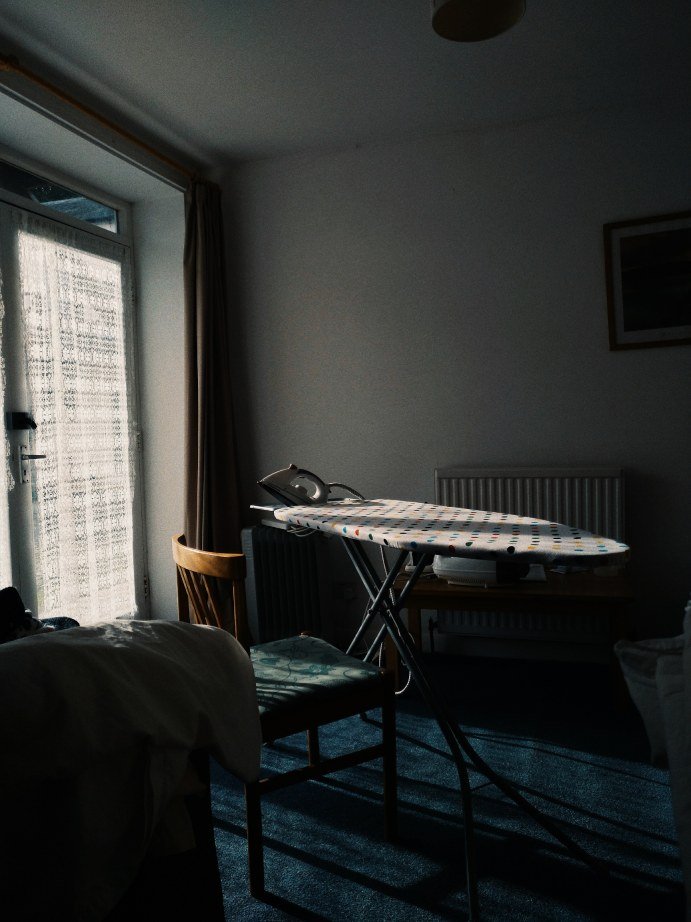
Ironing FAQs
What fabrics should not be ironed?
Avoid ironing sequins, velvet, decals, or other printed designs that will melt under the heat of an iron. In addition, do not iron clothes that are dirty or stained as the heat will set the stain into the fabric – sometimes permanently.
How to use the steam setting?
Use the steam setting when you want to add dampness to your clothes. This is particularly effective if your garment is not already damp or has tough wrinkles.
How do you prevent burn marks on clothes?
The usual reason why your iron is leaving burn marks is because the iron is dirty. Use a brush to scrub it using a baking soda and vinegar mixture. Use a clean cloth to wipe it off afterward.

Skip Ironing Hassles – Try Rinse Laundry Services
Ironing can be time-consuming, particularly, if you constantly iron your clothes for work each week. While the above tips will help you master the art of ironing at home, you can always outsource the chore to professional dry cleaners (pro tip: Rinse offers Dry Cleaning and Launder & Press!) who not only iron your clothes but properly clean them and treat them for stains.
Either option will give your clothes a professional look and feel and have you looking sharp and feeling confident. But that's not all – Rinse offers pickup and delivery services right to your door. All you have to do is schedule a pickup via our website, text, or our app and we'll come that same evening, any day of the week!
Contact us at Rinse today to see our skill in action.

Learn what type of laundry detergent is right for you.
Today, you have several options for laundry detergent, including laundry powder, liquid detergent, and laundry pods. This wasn’t always the case as liquid laundry detergent wasn’t introduced until the 1950’s. Before then, most consumers used powdered detergent and laundry pods weren’t invented until the 2000’s.
With three options now widely available, how do you know which is best? Below we’ll tell you everything you need to know about laundry detergent to help you choose the best detergent for you.
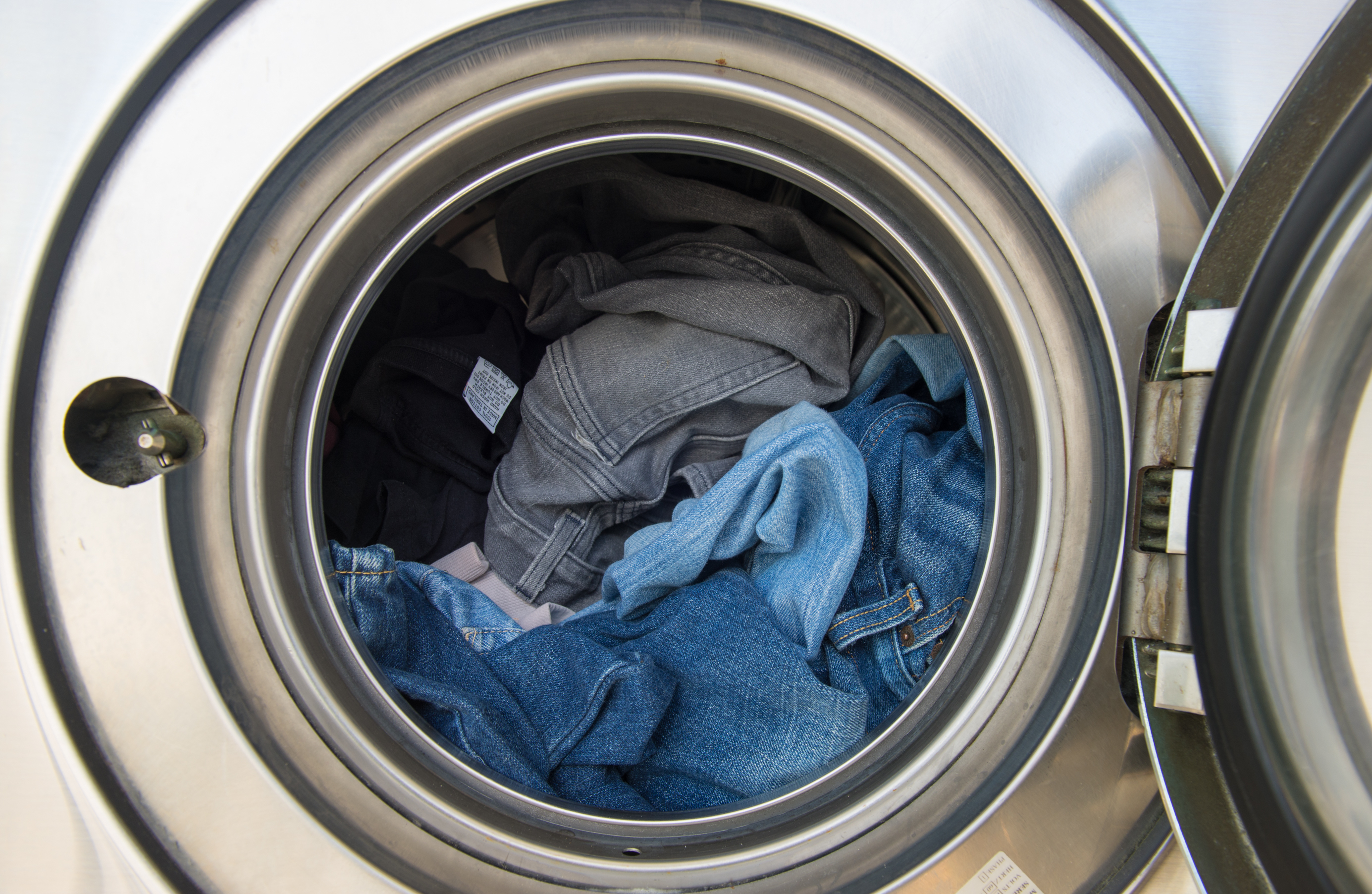
Powdered Laundry Detergent
First introduced in the 1930’s, powdered laundry detergent was once the go-to choice for consumers in America. Nowadays, you’ll be hard-pressed to find powdered detergent on the shelves at stores (but it remains popular in other countries). Nevertheless, it’s a cheaper option compared to liquid laundry soap and laundry pods and it will leave your clothes looking just as clean as the alternatives.
Why Choose Powdered Detergent
First and foremost, powdered detergent is not only cheaper but it will last longer as the properties it is made of have a longer shelf life relative to liquid laundry detergent. More importantly, powdered detergent is best for tough stains such as grass, clay, and mud stains as it contains linear alkylbenzene sulfonate, a surfactant compound which is effective in treating stains.
Additionally, powdered detergent is packaged in cardboard boxes which can be recycled more easily compared to plastic containers - making it the more eco-friendly choice among laundry detergents.
Powdered Detergent Cons
The main issue with powdered detergent is that it can leave residue in your washing machine, particularly if you are using very cold water since it may not dissolve fully into the water at that temperature. Additionally, the residue can also make its way onto your clothing, which will make them look dirty despite them being recently cleaned in the washing machine.
As mentioned previously, its packaging may be more environmentally-friendly but it is bulky and difficult to handle and store. The powder must be stored in a dry area so that it doesn’t lump together.
However, if you’re looking for ways to get rid of stubborn stains from your adventures outdoors and are actively looking for small ways to reduce your carbon footprint then we highly recommend you give powdered laundry detergent a try.
Liquid Laundry Detergent
Liquid laundry detergent is arguably the most popular choice when it comes to laundry soap. That’s because it’s easy to use and has dominated much of the market up until the introduction of laundry pods in the 2000’s.
Why Choose Liquid Laundry Detergent
Liquid laundry soap is relatively inexpensive, particularly compared to all-in-one laundry pods and is available in a wide variety of scents, which will leave your clothes smelling fresh. Because it is liquid, it easily mixes with the water inside the machine and is less likely to leave residue.
Also, liquid detergent is particularly useful in treating grease stains as it contains alcohol ethoxylates, which are effective on oil-based stains.
Liquid Detergent Cons
Liquid soap comes in bulkier plastic bottles and although they can be recycled they are a strain on the environment if they aren’t recycled properly. Additionally, the detergent is largely made up of water, which adds weight to the container and also is less environmentally efficient.
Another downside of liquid detergent is that it minimizes the effects of other cleaning agents such as oxygen bleach because they are not stable when mixed together in water.
There’s no doubt that liquid laundry soap will effectively clean your clothes. The fact that it comes in a variety of scents and is widely accessible makes it the most popular choice among consumers.
Laundry Pods
Laundry pods were first introduced to the laundry market in 2012 and were made famous by the Tide brand, who trademarked the term “pods” (Tide PODS). Laundry pods or pacs have quickly grown in popularity and overtaken laundry powder as the second most popular detergent choice.
Why Choose Laundry Pods
Laundry pacs are arguably the most convenient option on the detergent market. They are single-use pacs that contain detergent and are oftentimes mixed with other cleaning materials. They are meant to dissolve in water, which creates less mess and less work for you.
Each pac is pre-measured to eliminate the overuse of detergent (which can cause residue) and since there is a limited amount of water the cleaning agents inside the pod can remain stable for a longer period of time and yield a quality level of cleaning.
Laundry Pod Cons
Despite laundry pods being lightweight, pre-measured, easy, and consumer-friendly they do come at a cost - they are the most expensive detergent option on the market. Additionally, if you are washing clothes with heavy stains you may need to use more than one pod since each pac is on the smaller side and more detergent may be required to effectively treat certain soiled garments.
Nonetheless, laundry pods are a great choice if you’re looking for a simpler way to do laundry. And of course, you can explore professional cleaning services such as Rinse to take care of your laundry for you so you can focus your attention on more important things besides laundry detergent.

How To Remove Chocolate Stains From Your Clothes: A Complete Guide
Chocolate is a delightful treat, but when it finds its way onto your clothes, it can quickly become a nightmare. Chocolate stains are notorious for their stubbornness and can easily ruin your favorite outfit if not treated properly. Whether it’s a chocolate bar, chocolate milk, or a luscious dessert, acting quickly is key to preventing permanent damage. In this guide, we’ll walk you through effective methods for removing chocolate stains from different fabrics and even carpets. Plus, we’ll introduce you to a hassle-free solution with professional services like Rinse.
Does Chocolate Stain Your Clothes?
Yes, chocolate can stain your clothes, and it does so with a vengeance. Chocolate is composed of both oil and cocoa, making it a complex stain to remove. The oils in chocolate can penetrate deep into the fibers of your clothing, while the dark pigments can leave a visible mark. When chocolate melts and spreads, it becomes even more challenging to remove. That’s why it’s essential to tackle the stain as soon as possible before it has a chance to set.
Chocolate stains don’t have to be a permanent problem. By acting quickly and following the right steps, you can remove chocolate stains from your clothes, fabrics, and carpets. Remember to handle each fabric with care, and don’t hesitate to seek professional help for those particularly stubborn stains. With the right approach, your clothes can stay chocolate-free and look their best for years to come.

Steps You Can Try At Home to Remove Chocolate Stains
Before you panic, there are several steps you can try at home to remove chocolate stains from your clothes. Here’s a step-by-step guide:
Remove Excess Chocolate
The first step is to gently scrape off any excess chocolate from the fabric. Use a spoon, a butter knife, or another non-sharp utensil to do this. Avoid using anything sharp that could damage the fibers of your clothing. If the chocolate has already dried, you might be able to flake it off carefully. However, avoid rubbing it further into the fabric, as this could worsen the stain.
Carefully Rinse the Stained Area
Next, you’ll want to rinse the back of the stained area with cold water. It’s important to use cold water, as warm or hot water could cause the stain to set. By rinsing from the back, you help push the chocolate out of the fibers rather than allowing it to spread deeper or to other areas of the garment. Gently rinse until you notice the chocolate beginning to lift away.
Apply Laundry Detergent
After rinsing, apply a small amount of liquid laundry detergent directly to the stained area. Let the detergent sit on the stain for about five minutes to allow it to break down the chocolate. Afterward, soak the garment in cold water for 15 minutes, gently rubbing the fabric between your fingers every few minutes to loosen the stain. Continue this process until the stain begins to disappear. Finally, rinse the garment thoroughly and wash it according to the care label instructions.
For added effectiveness, consider using a stain remover pen or spray before laundering. Always follow the instructions on the product and the garment's care label.

How To Remove Chocolate Stains From Different Types Of Fabrics
Different fabrics require different care when it comes to stain removal. Here’s how to handle chocolate stains on a few common fabric types:
Jeans
Denim is a sturdy fabric, but it can still fall victim to chocolate stains. After removing any excess chocolate and rinsing with cold water, apply a generous amount of laundry detergent to the stained area. Let it sit for 10-15 minutes, then gently scrub with a soft brush or your fingers. Wash the jeans in cold water with a quality detergent. If the stain persists, repeat the process or consider using an oxygen bleach solution for extra stain-fighting power.
Silk
Silk is a delicate fabric, so you’ll need to treat chocolate stains with care. After scraping off excess chocolate, dab the stain with cold water. Mix a gentle detergent with cold water and apply it to the stained area using a soft cloth or sponge. Avoid rubbing, as this could damage the fabric. Let the solution sit for a few minutes, then rinse carefully with cold water. If the stain remains, consider taking the garment to a professional cleaner to avoid damaging the fabric further.
White Clothes
Chocolate stains on white clothes can be particularly stubborn. Start by removing excess chocolate and rinsing with cold water. Apply liquid laundry detergent and gently rub the fabric together. After allowing the detergent to work for 5-10 minutes, soak the garment in cold water mixed with a bit of hydrogen peroxide, which can help lift the stain without harming the fabric. You can also use oxygen bleach, which breaks down into hydrogen peroxide when mixed with water to get the same effect. Rinse thoroughly and wash as usual. Avoid using chlorine bleach, as it can cause yellowing on white fabrics.

How To Remove Chocolate Stains From Carpets
Chocolate stains aren’t just limited to clothes; they can also end up on your carpets. Here’s how to tackle chocolate stains on carpets:
Scrape Off Excess Chocolate
Begin by carefully scraping off any excess chocolate using a spoon or a blunt knife. Be gentle to avoid pushing the chocolate further into the carpet fibers.
Blot the Stain with Cold Water and Dish Soap
Mix a solution of cold water and a small amount of dish soap. Dampen a clean cloth with the solution and blot the stained area. Avoid scrubbing, as this can push the stain deeper into the carpet. Continue blotting until the chocolate starts to lift.
Rinse with Cold Water and Pat Dry
Once the chocolate has been removed, rinse the area with cold water to remove any soap residue. Blot the area with a dry cloth to absorb as much moisture as possible. If necessary, you can repeat the process until the stain is completely gone. Allow the carpet to air dry completely.

Keep Your Clothes Chocolate Stain-Free With Rinse
While these DIY methods can be effective, sometimes chocolate stains require a bit more expertise. That’s where professional services like Rinse come in. Rinse offers top-notch laundry and dry cleaning services that are perfect for tackling tough stains like chocolate. Our experts know how to treat delicate fabrics and stubborn stains without causing damage or shrinkage.
Rinse provides a convenient solution for those who want to ensure their clothes remain in pristine condition. With services like door-to-door pickup and delivery, Rinse makes it easy to keep your wardrobe fresh and stain-free. Whether you’re dealing with a chocolate mishap or simply want to maintain your favorite garments, Rinse is here to help.
And for more tips on stain removal and garment care, explore our blog where you can learn about everything from hot or cold water for stains to DIY hacks for summer stains. If you’re dealing with older stains or tough stains like grease, check out our guides on how to get old stains out of clothes and how to get grease out of clothes.
Our laundry experts know the proper care for all fabrics, making sure your clothes come out stain-free. Similarly, our dry cleaning practices keep your special outfits in good shape.
All we need from you is a bag filled with your dirty clothes. We'll take it from there — washing, drying, ironing, and folding.
Contact us at Rinse today to see our skill in action.

Have laundry or dry cleaning to do?
Rinse picks up, cleans and delivers 7 days a week. Amazingly awesome. Ridiculously simple.
Topics
Rinse Drop
We offer pickup and delivery if you can’t be present between 8pm and 10pm.
Our Valet will pick up or deliver your order to your doorstep or concierge, at which point you’ll receive a text with a photo showing where your items were left.
You can enable Rinse Drop on any (or all) of your orders.
Rush Delivery
We offer Next-Day Rush Delivery for Wash & Fold orders for an additional fee of $9.95.
Simply let your Valet know upon your pickup. There’s also an option to set a permanent preference for Rush Delivery in your My Account page.


